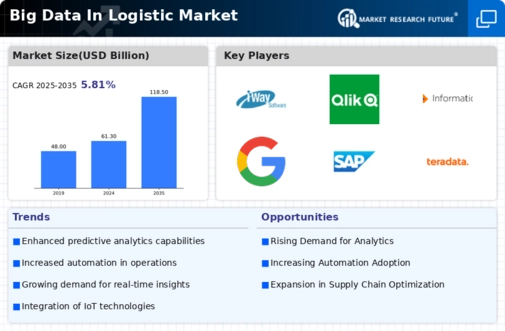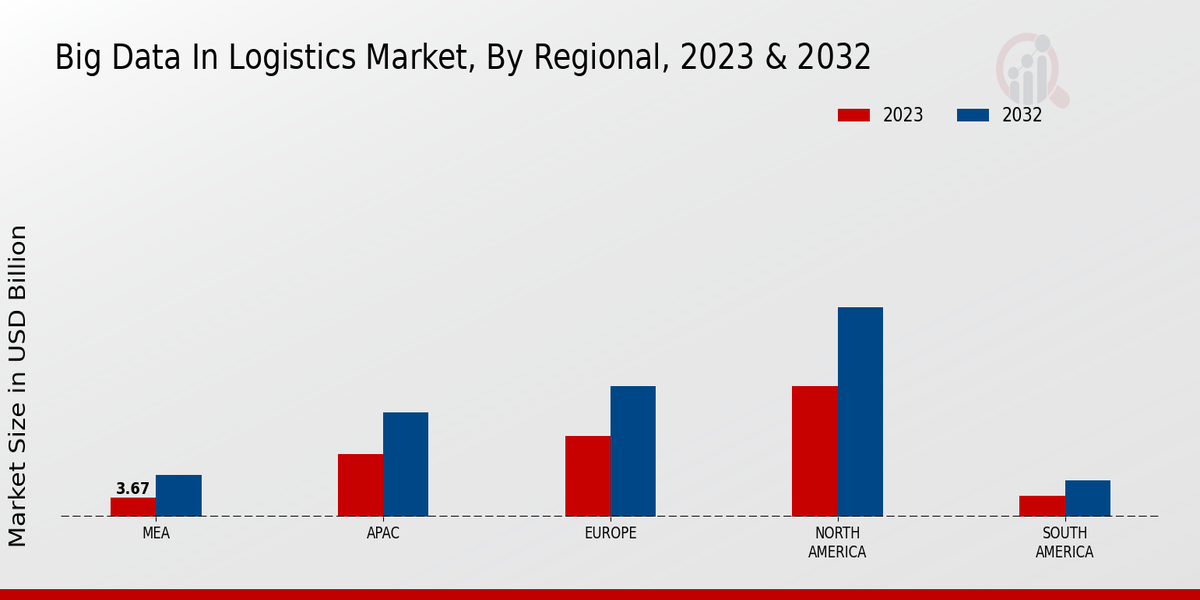Market Growth Projections
The Global Big Data In Logistic Market Industry is projected to reach a value of 61.3 USD Billion in 2024 and is expected to grow to 118.5 USD Billion by 2035. This growth trajectory indicates a compound annual growth rate of 6.17% from 2025 to 2035. Such projections highlight the increasing reliance on big data analytics within the logistics sector, as companies seek to optimize operations and enhance customer experiences. The anticipated growth reflects the industry's adaptation to technological advancements and evolving consumer demands, positioning big data as a cornerstone of future logistics strategies.
Rising E-Commerce Activities
The exponential growth of e-commerce activities is a key driver for the Global Big Data In Logistic Market Industry. As online shopping continues to gain traction, logistics companies are compelled to adopt big data solutions to manage increased order volumes and customer expectations. For instance, data analytics can optimize inventory management and streamline last-mile delivery processes. The market's projected compound annual growth rate of 6.17% from 2025 to 2035 underscores the importance of big data in addressing the complexities of e-commerce logistics. Companies that effectively harness big data analytics are likely to gain a competitive edge in this rapidly evolving landscape.
Advancements in IoT Technology
The integration of Internet of Things (IoT) technology significantly propels the Global Big Data In Logistic Market Industry forward. IoT devices enable the collection of vast amounts of data from various sources, such as vehicles, warehouses, and supply chains. This data can be analyzed to gain insights into operational performance and identify areas for improvement. For example, smart sensors can monitor temperature and humidity levels during transportation, ensuring product quality. As the market evolves, the anticipated growth to 118.5 USD Billion by 2035 suggests that IoT will play a crucial role in shaping logistics operations and enhancing data-driven decision-making.
Enhanced Supply Chain Visibility
Enhanced supply chain visibility is increasingly recognized as a vital component of the Global Big Data In Logistic Market Industry. Organizations are investing in big data solutions to gain comprehensive insights into their supply chains, enabling them to identify bottlenecks and inefficiencies. By utilizing data analytics, companies can track shipments in real-time, monitor supplier performance, and forecast demand more accurately. This level of visibility not only improves operational efficiency but also fosters stronger relationships with partners and customers. As the market continues to expand, the ability to leverage big data for enhanced visibility will likely become a standard practice in logistics.
Regulatory Compliance and Risk Management
Regulatory compliance and risk management are critical drivers within the Global Big Data In Logistic Market Industry. As regulations surrounding transportation and logistics become more stringent, companies are increasingly turning to big data analytics to ensure compliance and mitigate risks. By analyzing data related to safety, environmental impact, and operational practices, organizations can identify potential compliance issues before they escalate. This proactive approach not only safeguards against penalties but also enhances overall operational integrity. As the industry evolves, the integration of big data analytics into compliance strategies will likely become essential for maintaining competitiveness and operational resilience.
Increasing Demand for Real-Time Data Analytics
The Global Big Data In Logistic Market Industry experiences a surge in demand for real-time data analytics. Companies are increasingly leveraging big data technologies to enhance operational efficiency and decision-making processes. For instance, logistics firms utilize real-time tracking systems to monitor shipments, optimize routes, and reduce delivery times. This trend is reflected in the projected market value of 61.3 USD Billion in 2024, indicating a robust growth trajectory. The ability to analyze vast amounts of data in real-time allows businesses to respond swiftly to market changes, thereby improving customer satisfaction and potentially increasing market share.














